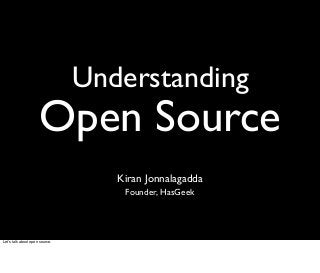Melden
Teilen
Downloaden Sie, um offline zu lesen

Empfohlen
Empfohlen
Weitere ähnliche Inhalte
Mehr von Kiran Jonnalagadda
Mehr von Kiran Jonnalagadda (10)
The technology of the Human Protein Reference Database (draft, 2003)

The technology of the Human Protein Reference Database (draft, 2003)
Kürzlich hochgeladen
Kürzlich hochgeladen (20)
IAC 2024 - IA Fast Track to Search Focused AI Solutions

IAC 2024 - IA Fast Track to Search Focused AI Solutions
2024: Domino Containers - The Next Step. News from the Domino Container commu...

2024: Domino Containers - The Next Step. News from the Domino Container commu...
How to Troubleshoot Apps for the Modern Connected Worker

How to Troubleshoot Apps for the Modern Connected Worker
What Are The Drone Anti-jamming Systems Technology?

What Are The Drone Anti-jamming Systems Technology?
TrustArc Webinar - Stay Ahead of US State Data Privacy Law Developments

TrustArc Webinar - Stay Ahead of US State Data Privacy Law Developments
Strategies for Landing an Oracle DBA Job as a Fresher

Strategies for Landing an Oracle DBA Job as a Fresher
The 7 Things I Know About Cyber Security After 25 Years | April 2024

The 7 Things I Know About Cyber Security After 25 Years | April 2024
Boost PC performance: How more available memory can improve productivity

Boost PC performance: How more available memory can improve productivity
Raspberry Pi 5: Challenges and Solutions in Bringing up an OpenGL/Vulkan Driv...

Raspberry Pi 5: Challenges and Solutions in Bringing up an OpenGL/Vulkan Driv...
Understanding Discord NSFW Servers A Guide for Responsible Users.pdf

Understanding Discord NSFW Servers A Guide for Responsible Users.pdf
Scaling API-first – The story of a global engineering organization

Scaling API-first – The story of a global engineering organization
Tech Trends Report 2024 Future Today Institute.pdf

Tech Trends Report 2024 Future Today Institute.pdf
Understanding Open Source
- 1. Understanding Open Source Kiran Jonnalagadda Founder, HasGeek Let’s talk about open source.
- 2. FOSS Free and Open Source Software Free Speech, not Free Beer You are no doubt familiar with the term “FOSS”, for Free and Open Source Software. You probably are aware that “free” refers to free speech, not free beer, and that the movement began in the ’80s under the leadership of Richard Stallman.
- 3. OSS Open Source Software But we are not talking about Free Software today. We are talking about Open Source. Free Software and Open Source are the same thing on the surface, but come from completely different viewpoints, and Open Source is typically poorly understood.
- 4. Three Principles 1. Commoditization 2. Complementary Goods 3. Platform & Infrastructure Let’s look at three principles that affect intellectual property, innovation, competition and how we come to use the things we do.
- 5. Commoditization From Premium to Commodity Many new innovations come to market as premium products protected by patents and copyright. The innovator benefits from their innovation, but as the product becomes more and more integrated into society, there’s rising pressure from clones and alternatives that provide similar functionality, until the functionality becomes commoditized.
- 6. The replication cost of a digital product is zero Computers work by copying bits from one place to another for every little operation Commoditization forces down the price of physical goods until there’s no “premium” margin. The price you pay is basically the price of manufacturing and distribution. With digital goods, there is no replication cost, so prices tend towards zero, either via piracy or open source alternatives.
- 7. Complementary Goods Cars and Roads Blades and Razors Toothpaste and Toothbrushes Applications and Operating Systems Many goods require something else in order to be usable, so producers of one are incentivized to commoditize the other. If you sell database software, it helps if you don’t have to sell your client the operating system as well. That is why enterprise vendors invest in Linux.
- 8. Platform Infrastructure What you sell is your platform and everything below it is infrastructure. You want to keep the platform yours, but make everyone else share the cost of infrastructure (by open sourcing it and getting others to use it). The risk is that your platform is someone else’s infrastructure, and they are incentivized to commoditize you.
- 9. Linux: 75% of all kernel development is done by developers who are being paid for their work http://www.linuxfoundation.org/news-media/announcements/2012/04/linux-foundation-releases-annual-linux-development-report Just how much of open source is produced by commercial entities with a profit motive? The Linux Foundation says 75%, contrary to popular opinion that open source is mostly produced by amateurs who believe software should be free.
- 10. GNOME Desktop: over 70% of the commits to the GNOME releases are made by paid contributors (as per 2010 census) https://blogs.gnome.org/bolsh/2010/07/28/gnome-census/ And it’s not just the Linux kernel. The GNOME project reports similar figures. You’ll find this to be the case with any large open source project that is an infrastructure layer for other projects.
- 11. Dual Premium Licensing Functionality Services Open Source The three main ways to run a commercial operation that produces open source: 1. Dual licensing (typically with copyright assignment), a popular but increasingly distrusted model; 2. Premium functionality in a commercial release, which tends to discourage others from becoming stakeholders in the project; and 3. Services or products that aren’t sold as code. Some of the best examples of successful open source projects are in this category, including projects as diverse as Linux, GNOME/KDE, Chromium/Firefox and OpenStack/CloudStack.
